Presentation | Fear of cold Cold limbs Likes to lie in curled up position Likes warmth Fatigued spirit Somnolence with dislike of speaking |
Primary disease diagnosis | Yang deficiency Qi deficiency |
Case example | Post recovery from fever due to upper respiratory tract infection, with injury to yang by external wind cold and low grade fever due to qi deficiency. |
Difficulty maintaining support with a cane Wobbles left and right Difficulty taking steps |
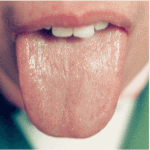 |
Liver and kidney insufficiency Injury to sinew and/or bone | Presentation |
Sequelae of infantile paralysis; Damp-heat wilting syndrome Tongue diagnosis has various aspects, including inquiry of the feeling of the tongue (as in tastes and flavors), and palpation techniques-general palpation, rubbing, wiping and scraping. However, inspection of the tongue is the most important aspect to diagnosis. | Primary disease? diagnosis |
Essentially there are two main parts of tongue inspection-examining | Case example |
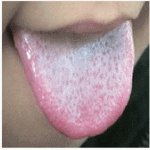 |
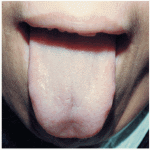 |
how to distinguish the diagnostic criteria. With the combined use of the four examinations to summarize diagnosis, the accuracy of one’s disease differentiation will also improve. | Presentation |
Light red tongue body Thin white tongue coat Moderate size and texture of the tongue body Agile in movement Tongue surface is especially supple and lustrous | Primary disease diagnosis |
Case example |
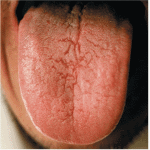 |
Presentation | Light red tongue body Thin white tongue coat, slightly thick at the middle and root Agile in movement Tongue surface is especially supple |
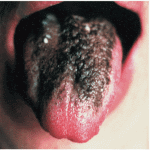 |
Primar disease diagnosis | Health persons External contractions of wind, cold and/or damp pathogens | Presentation |
Case example | Exterior syndrome-exterior contraction of damp-cold, with no injury to the right qi Pale white and thin tongue body Slightly glossy, thin white coating | Primary disease diagnosis |
Yang deficiency | Case example |
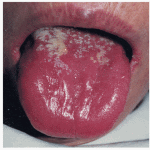 |
Presentation | Kidney yang deficiency with qi and blood insufficiency; Aplastic anemia Red, aged-looking tongue body Plentiful cracks in the center Thick, dry and cracked white coating transforming into yellow, followed by curd-like coating |
Primary disease diagnosis | Exuberant heat injuring yin Phlegm-fire Food accumulation |
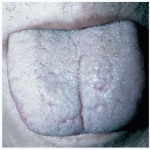 |
Presentation | |||
Case example | Turbid phlegm congesting the lung with exuberant heat injuring yin Pulmonary infection | Crimson tongue body Multiple red spots at the tongue tip Dry, charred black tongue coat | Primary disease diagnosis |
Heat entering the ying and blood level with extreme heat injuring fluids Hyperactivity of fire due to yin deficiency Blood stasis | Case example? |
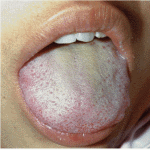 |
Presentation Delicate, tender crimson-purple tongue body Tongue appears bare and lustrous, with no coating Slight rootless, grimy, pale-yellow coating at the root (rootless, false coating) | |
Primary disease diagnosis | Exuberant heat injuring yin and drying yin fluids Internal obstruction due to blood stasis |
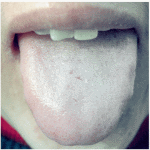 |
Internal accumulation of alcohol toxins Damp turbidity remaining, not yet exhausted | Presentation | |
Case example | Phlegm-heat injuring yin with internal obstruction from blood stasis, and exhaustion of stomach qi; Late-stage liver cancer. | |
Blue-purple tongue body Plentiful cracks in the center Tongue coat is white, thick, greasy, glossy and moist | Primary disease diagnosis | |
Spleen deficiency with dampness Cold-dampness blocked internally | Case example |
Stay updated, free articles. Join our Telegram channel

Full access? Get Clinical Tree








